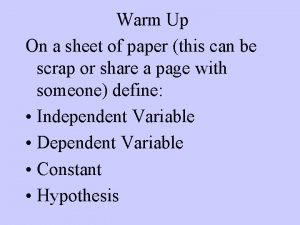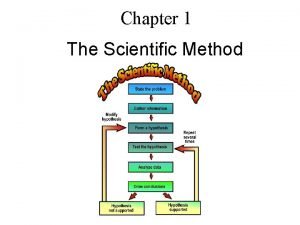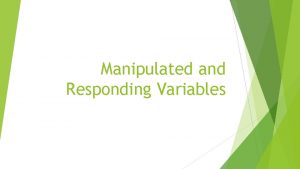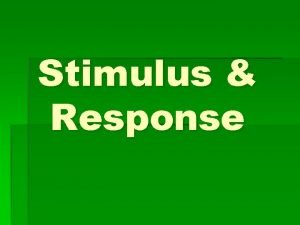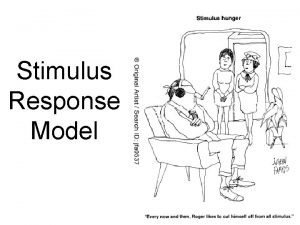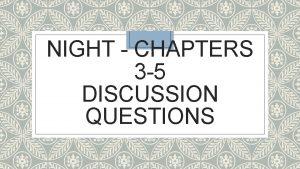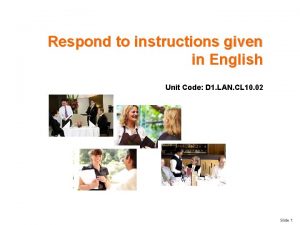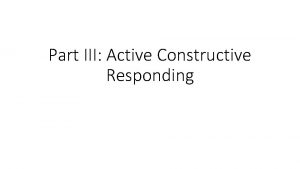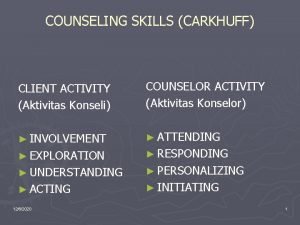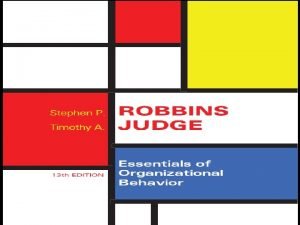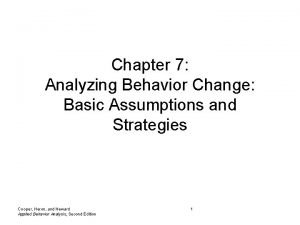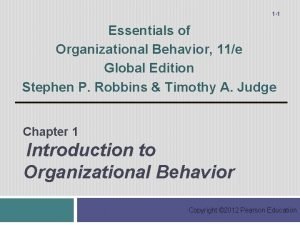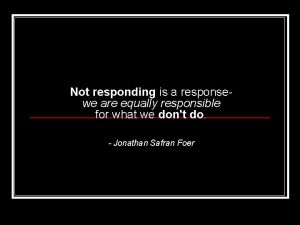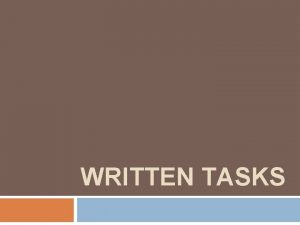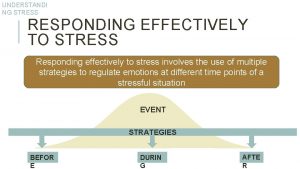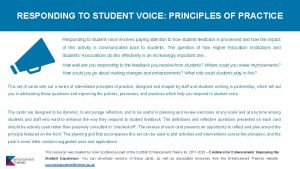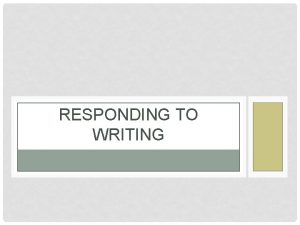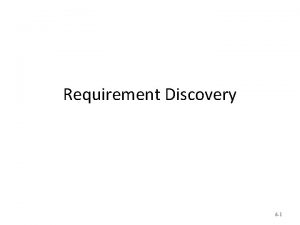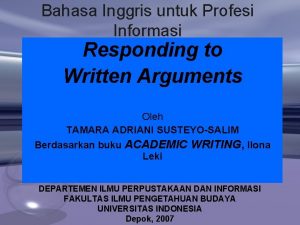Introduction to Written Discovery Propounding and Responding Written





























- Slides: 29

Introduction to Written Discovery Propounding and Responding Written Discovery in Civil Cases: The Basics

What is Discovery? n n The formal process that a party in a lawsuit uses to obtain information and evidence from another party in that lawsuit. Discovery is available to both plaintiffs and defendants. Most discovery is in writing, some of which we will cover today. Discovery not covered today includes depositions, medical and physical examinations, etc.

Why? To “discover” what evidence the other side has. n To “discovery” the other side’s version of the story. n To hold the other side to that version of the story at trial. n

Ideal Flow of Written Discovery: Discovery is conducted between the parties, without the Involvement of the Court. Ask 30 days Respond • Propounding party serves the written discovery request on the responding party’s attorney of record (or on In Pro Per responding party). • Typically 30 days to respond to request (add 5 days if service is by mail). • Responding party serves a written response to the Propounding party. Note: If there are more than 2 parties, courtesy copies Are served on all other parties/attorneys.

When Can Discovery Happen? n n Plaintiff must wait at least 10 days after defendant is served with the Summons to serve a discovery request (unless a motion grants permission). This is rarely an issue. Discovery must be completed at least 30 days before first date set for trial (or 15 days before judicial arbitration), and discovery motions heard 15 days before trial. • Anticipate problems. The time runs very quickly, so don’t delay.

Limits on Scope of Discovery requests must be reasonably calculated to lead to the discovery of relevant, admissible evidence. n The evidence discovered does not itself need to be admissible at trial. n Privileged information (i. e. protected by a privilege such as the attorney-client relationship) cannot be discovered. n Other limitations exist. n

Request for Admissions Purpose: To ask another party to admit to certain facts, or to admit that certain documents are authentic, so that these facts do not need to be proven or documents authenticated at trial. n Form: Can be hand-plead, or Judicial Council form DISC-020 with attachments. n Frequently used to “sucker punch” selfrepresented litigants who do not respond. n

Procedure for Propounding Request for Admissions 1. 2. 3. Complete Request for Admissions form. Copy of Request for Admissions is served on responding party (service by mail is OK if the responding party is the plaintiff, or a defendant who has filed an Answer), along with an unsigned copy of the Proof of Service, if mailed. Original Request for Admissions and Proof of Service are retained. They are not filed with the Court at this time.

Judicial Council Form Disc 020 n Your name and address. n n The Court’s address The case name Fill your name in as the Requesting Party. Then responding party is the Answering Party. The Set No. is “ 1” or “One” if this is your first set. Check box 1 to list facts that you want admitted, and box 2 for authentication of documents. You will likely need to attach pages.

Sample Responses to Request for Admission n n Your name and address goes at the top of the form. The caption contains information about the case. Your answer can admit part of a question, but deny other parts. The response must be verified, meaning you must swear that the responses given are true.

Procedure for Propounding Interrogatories 1. 2. 3. Complete appropriate Interrogatories (Form or Special). Copy of Interrogatories is served on responding party (service by mail is OK if the responding party is the plaintiff, or a defendant who has filed an Answer), along with an unsigned copy of the Proof of Service, if mailed. Original Interrogatories and Proof of Service are retained. They are not filed with the Court at this time.

Form Interrogatories n n n Easy to use Judicial Council form for commonly asked interrogatories. In limited civil cases (under $25, 000), use Form Interrogatories- Limited Civil Cases (Economic Litigation) (DISC-004)that have no subparts. In unlimited cases, chose one or more of forms DISC-001 Form Interrogatories – General, or DISC-002, Form Interrogatories. Employment Law (you can also use DISC 004, if you wish).

n n n n Completing Form Interrogatories Your name and address. The Court’s name The title of the case Case number Fill your name in as the Requesting Party. Then responding party is the Answering Party. The Set No. is “ 1” or “One” if this is your first set. On the following pages, choose which questions you wish to ask by checking boxes next to the questions you wish to ask. Note: There is no place for you to sign the Form Interrogatories.

Responding to Interrogatories Response must be in writing. n No Judicial Council form. n Typically on “pleading paper, ” which can be created in any modern word processor. n Answers are numbered, and answers are given in the same order that the questions are asked. n Must be verified (sworn as true). n

Responding to Form Interrogatories n n n Your name and address goes at the top of the form. The caption contains information about the case. Each answer is numbered like the interrogatory, and are answered in the same order. Answer each question, being careful to answer each subpart, if one exists. Read the question carefully, and answer only what it asks. You may attach exhibits, if necessary. The response must be verified, meaning you must swear that the responses given are true.

Propounding Special Interrogatories Special interrogatories ask questions that are not included in the Form Interrogatories. n Hand-drafted on pleading paper. n Cannot have subparts. n Should be drafted with care to avoid common pitfalls. n

Completing Special Interrogatories n n n Your name and address goes at the top of the form. The caption contains information about the case. General information and definitions are listed. Each question is numbered sequentially. Do not include a preface, instructions, subparts, or a compound, conjunctive, or disjunctive question. Do not include any continuing interrogatories. Any term specially defined must be typed in all capital letters. Sign and date the Special Interrogatories at the end. See the full sample in your handout.

Responding to Special Interrogatories n n Form and Special Interrogatories are answered the same way, only the titles and numbers change. Be sure to verify your response!

Requests for Production/ Demand for Inspection n Used by one side to inspect and copy documents or other tangible evidence held by another party (it cannot be used to get information from a non-party). No Judicial Council form, instead, it is created on pleading paper. Production is typically of the original documents, to be inspected and copied while a someone waits, however the request may allow copies to be sent instead.

Request for Production n n Your name and address goes at the top of the form. The caption contains information about the case. Describe what you are requesting (i. e. inspection and copying, testing, etc). Describe each category of document or thing to be produced.

Request for Production (cont. ) n n n Describe the time and place the production is to take place (time must be at least 30 days after personal service, or 35 days after service by mail inside of California), and, optionally, whether you will accept copies instead with a sworn statement that they are authentic. Date and sign. You should chose a location for production where you will be able to perform the copying, since you will not be able to hold onto the original documents beyond the time needed to inspect and copy them.

Responding to Request for Production n n Your name and address goes at the top of the form. The caption contains information about the case. Respond to each request indicating that you will comply, or why you cannot comply (i. e. what happened to the documents, or who has them), or make your objection. Must be verified unless it contains only objections (objections do not need to be verified)

Timing the Request for Production Give at least 30 days from date of service (35 days if by mail in California) to produce. n Written response must be served within 30 days (35 days if served by mail in California), and is independent from the actual production. n

Limits on Quantity of Discovery n Limited civil cases (Under $25, 000): n n n 35 combined form interrogatories with no subparts, special interrogatories, request for admission, and request for production. If more discovery is required, must seek leave of the court through a motion. Unlimitied civil cases (Over $25, 000): n n n Unlimited form interrogatories, request for production. 35 each special interrogatories, request for admission, more can be obtained if declaration justifying need is completed. If discovery is abusive, responding party may file a motion seeking a protective order limiting discovery.

General Tips n n Discovery is conducted outside the Court. The Court anticipates minor issues to be worked out informally between the parties. Communicate. Plan on completing your discovery early. Because discovery must be completed at least thirty days before the first date set for trial, or 15 days before arbitration, whichever is earlier. This means that the last round of discovery must be out at least 60 days before trial or 45 days before arbitration (add 5 days if served by mail in California).

General Tips (cont. ) n n Create a strategy. Determine what you need to prove to win your case, and make discovery requests that help you obtain the information you need. Sometimes establishing what the other side doesn’t have is more important than establishing what they do have.

General Tips (cont. ) n n Don’t use all of your discovery requests at once. Save at least a few in case you have follow-up questions, or the first set of discovery reveals new avenues that need to be investigated. Remember- all discovery requests must be “served” by a person over the age of 18 who is not a party to the case (i. e. not you).

Penalties for Non Compliance n n If a side fails to comply the asking side files a motion with the court to order compliance (or in the case of Request for Admissions, a motion to deem each of the facts asserted as true. The result of these motions could include financial sanctions, or even the loss of the case.

Other Resources: n n Win Your Lawsuit by Nolo Press, Chapter 10 (Self-Help Section) California Practice Guide: Civil Procedure Before Trial by The Rutter Group, Chapter 8, (KFC 995. W 45 v. 2) CEB Action Guide- Obtaining Discovery: Initiating and Responding to Discovery Procedures (KFC 1020. Z 9 T 53 or On. Law) CEB Action Guide- Creating Your Discovery Plan (KFC 1020. Z 9 C 74 or On. Law)
 Propounding discovery
Propounding discovery Introduction to data mining and knowledge discovery
Introduction to data mining and knowledge discovery Manipulated variable and responding variable graph
Manipulated variable and responding variable graph Why are line graphs powerful tools in science
Why are line graphs powerful tools in science Expression of congratulating
Expression of congratulating What is the fourth step of the scientific method
What is the fourth step of the scientific method Manipulated variable
Manipulated variable Making and responding to requests 2 bac
Making and responding to requests 2 bac Understanding behaviour responding safely
Understanding behaviour responding safely Responding to internal stimuli
Responding to internal stimuli Stimulus in body temperature
Stimulus in body temperature Night chapter questions
Night chapter questions Keywords for affective domain
Keywords for affective domain An indirect, dishonest way to control or influence others
An indirect, dishonest way to control or influence others _____ is done with the first responding officer.
_____ is done with the first responding officer. The most dramatic force shaping our destiny is
The most dramatic force shaping our destiny is Responding to internal stimuli
Responding to internal stimuli Responding to the environment
Responding to the environment He understands the instructions given by the agent
He understands the instructions given by the agent Active constructive responding
Active constructive responding Eft cycle
Eft cycle 4 crisis development behavior levels
4 crisis development behavior levels Attending responding personalizing initiating
Attending responding personalizing initiating Responding to economic pressures
Responding to economic pressures Prediction verification replication aba
Prediction verification replication aba Responding to economic pressures in ob
Responding to economic pressures in ob Natural environment marketing
Natural environment marketing Not responding is a response
Not responding is a response Responding to globalization in ob
Responding to globalization in ob Macro environment in marketing
Macro environment in marketing


